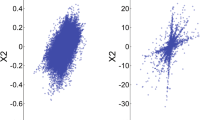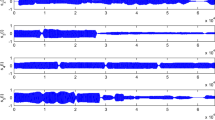Abstract
Underdetermined blind source separation (UBSS) is a hard problem to solve since its mixing system is not invertible. The well-known “two-step approach” has been widely used to solve the UBSS problem and the most pivotal step is to estimate the underdetermined mixing matrix. To improve the estimation performance, this paper proposes a new clustering method. Firstly, the observed signals in the time domain are transformed into sparse signals in the frequency domain; furthermore, the linearity clustering of sparse signals is translated into compact clustering by normalizing the observed data. And then, the underdetermined mixing matrix is estimated by clustering methods. The K-means algorithm is one of the classical methods to estimate the mixing matrix but it can only be applied to know the number of clusters in advance. This is not in accord with the actual situation of UBSS. In addition, the K-means is very sensitive to the initialization of clusters and it selects the initial cluster centers randomly. To overcome the fatal flaws, this paper employs affinity propagation (AP) clustering to get the exact number of exemplars and the initial clusters. Based on those results, the K-means with AP clustering as initialization is used to precisely estimate the underdetermined mixing matrix. Finally, the source signals are separated by linear programming. The experimental results show that the proposed method can effectively estimate the mixing matrix and is more suitable for the actual situation of UBSS.










Similar content being viewed by others
References
T. Adalı, C. Jutten, A. Yeredor, A. Cichocki, E. Moreau, Source separation and applications. IEEE Signal Process. Mag. 31(3), 16–17 (2014)
H. Akaike, A new look at the statistical model identification. IEEE Trans. Autom. Control 19(6), 716–723 (1973)
S. Arberet, R. Gribonval, F. Bimbot, A robust method to count and locate audio sources in a multichannel underdetermined mixture. IEEE Trans. Signal Process. 58(1), 121–133 (2010)
P. Bofill, M. Zibulevsky, Underdetermined blind source separation using sparse representations. Sig. Process. 81, 2353–2362 (2001)
H. Bozdogan, Mixture-model cluster analysis using model selection criteria and a new information measure of complexity. in Proceedings of the 1st US/Japan Conference on the Frontiers of Statistical Modeling: An Informational Approach (Dordrecht: Kluwer Academic Publishers, 1994), pp. 69–113
H. Bozdogan, Akaike’s information criterion and recent developments in model complexity. J. Math. Psychol. 44, 62–91 (2000)
P. Comon, C. Jutten, Handbook of Blind Source Separation: Independent Component Analysis and Applications (Academic Press, Oxford, 2010)
J. Deller, J. Hansen, J. Proakis, Discrete-Time Processing of Speech Signals (IEEE Press, Piscataway, NJ, 2000)
M. Elad, Sparse and Redundant Representations: From Theory to Applications in signal and image processing (Springer, New York, 2010)
J. Eric Ward, A review and comparison of four commonly used Bayesian and maximum likelihood model selection tools. Ecol. Model. 211, 1–10 (2008)
G. Fanglin, H. Zhang, D. Zhu, Blind separation of non-stationary sources using continuous density hidden Markov models. Digit. Signal Process. 23(5), 1549–1564 (2013)
B.J. Frey, Clustering by passing messages between data points. Science 315, 972–976 (2007)
Y. Guo, S. Huang, Y. Li, G.R. Naik, Edge effect elimination in single-mixture blind source separation. Circuit. Syst. Signal Process. 32(5), 2317–2334 (2013)
X. He, F. Wang, W. Chai, W. Liangmin, Ant colony clustering algorithm for underdetermined BSS. Chin. J. Electron. 22(2), 319–324 (2013)
R.A. Hummel, M.S. Landy, A statistical viewpoint on the theory of evidence. IEEE Trans. Pattern Anal. Mach. Intell. 10(2), 235–247 (1988)
R. Kass, Bayes factors in practice. J. R. Stat. Soc. Ser. D (Statistician) 42, 551–560 (1993)
R. Kass, A.E. Raftery, Bayes factors. J. Am. Stat. Assoc. 90, 773–795 (1995)
A. Kawamura, E. Nada, Y. Iiguni, Single channel blind source separation of deterministic sinusoidal signals with independent component analysis. IEICE Commun. Express 2(3), 104–110 (2013)
LDS, Application Note AN014 on Understanding FFT Windows, http://www.physik.uni-wuerzburg.de
Y. Li, A. Cichocki, S.-I. Amari, Analysis of sparse representation and blind source separation. Neural Comput. 16(6), 1193–1234 (2004)
Y. Li, S.-I. Amari, A. Cichocki, D.W.C. Ho, S. Xie, Underdetermined blind source separation based on sparse representation. IEEE Trans. Signal Process. 54(2), 423–437 (2006)
A. Lombard, Y. Zheng, H. Buchner, W. Kellermann, TDOA estimation for multiple sound sources in noisy and reverberant environments using broadband independent component analysis. IEEE Trans. Audio Speech Lang. Process. 19(6), 1490–1503 (2011)
P. Mowlaee, R. Saeidi, M.G. Christensen, Z.-H. Tan, T. Kinnunen, P. Fränti, S. Holdt, A joint approach for single-channel speaker identification and speech separation. IEEE Trans. Audio Speech Lang. Process. 20(9), 2586–2601 (2012)
G.R. Naik, D. Kant Kumar, Determining number of independent sources in undercomplete mixture. EURASIP J. Adv. Signal Process. 2009, 1–5 (2009)
G.R. Naik, D. Kant Kumar, An overview of independent component analysis and its applications. Inform. Int. J. Comput. Inform. 35, 63–81 (2011)
G.R. Naik, D. Kant Kumar, Dimensional reduction using blind source separation for identifying sources. Int. J. Innov. Comput. Inform. Control 7(2), 989–1000 (2011)
F. Nesta, M. Omologo, Convolutive Underdetermined Source Separation Through Weighted Interleaved ICA and Spatio- Temporal Source Correlation. Latent Variable Analysis and Signal Separation (Springer, Berlin, 2012), pp. 222–230
J. Nikunen, T. Virtanen, Direction of arrival based spatial covariance model for blind sound source separation. IEEE/ACM Trans. Audio Speech Lang. Process. 22(3), 727–739 (2014)
T. Otsuka, K. Ishiguro, H. Sawada, H.G. Okuno, Bayesian nonparametrics for microphone array processing. IEEE/ACM Trans. Audio Speech Lang. Process. 22(2), 493–504 (2014)
R. Rubinstein, A.M. Bruckstein, M. Elad, Dictionaries for sparse representation modeling. Proc. IEEE 98(6), 1045–1057 (2010)
X. Rui, D.C. Wunsch II, Clustering (IEEE Press and Wiley, New Jersey, 2009)
V. Saeed, Vaseghi, Advanced Digital Signal Processing and Noise Reduction, 4th edn. (Wiley, Chichester, 2008)
H. Sawada, S. Araki, S. Makino, Underdetermined convolutive blind source separation via frequency bin-wise clustering and permutation alignment. IEEE Trans. Audio Speech Lang. Process. 19(3), 516–527 (2011)
G. Schwarz, Estimating the dimension of a model. Ann. Stat. 6(2), 461–464 (1978)
P. Smyth, Clustering using Monte Carlo cross-validation. in Proceedings of the 2nd International Conference on Knowledge Discovery and Data Mining (New York, NY: AAAI Press, 1996), pp. 126–133
M. Souden, K. Kinoshita, M. Delcroix, T. Nakatani, Location feature integration for clustering-based speech separation in distributed microphone arrays. IEEE/ACM Trans. Audio Speech Lang. Process. 22(2), 354–367 (2014)
D.J. Spiegelhalter, N.G. Best, B.P. Carlin, A. van der Linde, Bayesian measures of model complexity and fit. J. R. Stat. Soc. Ser. B (Stat. Methodol.) 64(4), 583–639 (2002)
B. Tan, S. Xie, Underdetermined blind separation based on source signals’ number estimation. J. Electron. Inf. Technol. 30(4), 863–867 (2008)
N. Tengtrairat, Bin Gao, W. L. Woo, S. S. Dlay, Single-channel blind separation using pseudo-stereo mixture and complex 2-D histogram. IEEE Trans. Neural Netw. Learn. Syst. 24(11), 1722-1735 (2013)
F.J. Theis, C.G. Puntonet, E.W. Lang, Median-based clustering for underdetermined blind signal processing. IEEE Signal Process. Lett. 13(2), 96–99 (2006)
E. Vincent, R. Gribonval, C. Févotte, Performance measurement in blind audio source separation. IEEE Trans. Audio Speech Lang. Process. 14(4), 1462–1469 (2006)
E. Vincent, N. Bertin, R. Gribonval, F. Bimbot, From blind to guided audio source separation. IEEE Signal Process. Mag. 31(3), 107–115 (2014)
J. Wen, H. Liu, S. Zhang, M. Xiao, A new fuzzy K-EVD orthogonal complement space clustering method. Neural Comput. Appl. 24(1), 147–154 (2014)
J. Wright, Y. Ma, J. Mairal, G. Sapiro, T.S. Huang, S. Yan, Sparse representation for computer vision and pattern recognition. Proc. IEEE 98(6), 1031–1044 (2010)
J.-J. Yang, H.-L. Liu, Blind identification of the underdetermined mixing matrix based on K-weighted hyperline clustering. Neurocomputing 149, 483–489 (2015)
M. Zibulevsky, M. Elad, \(L_{1}-L_{2}\) optimization in signal and image processing. IEEE Signal Process. Mag. 27, 76–88 (2010)
Acknowledgments
Funding for this work was supported by the National Natural Science Foundation of China [No. 60572183] and the Research Projects of the Open Fund Project of Key Laboratory in Hunan Universities [No. 14K022].
Author information
Authors and Affiliations
Corresponding author
Rights and permissions
About this article
Cite this article
He, Xs., He, F. & Cai, Wh. Underdetermined BSS Based on K-means and AP Clustering. Circuits Syst Signal Process 35, 2881–2913 (2016). https://doi.org/10.1007/s00034-015-0173-7
Received:
Revised:
Accepted:
Published:
Issue Date:
DOI: https://doi.org/10.1007/s00034-015-0173-7




